Sustainable Population Size at the County Level under Limited Development Policy Constraints: Case Study of the Xihaigu Mountain Area, Northwest China
Abstract
1. Introduction
2. Conceptual Framework
3. Study Area
4. Methods and Data
4.1. Research Methods
4.1.1. Population-Size and Environment-Quality Model
- (1).
- Population-Size and Environment-Quality Analytical Framework
- (2).
- Model Calculation
- If β1 ≠ 0, β2 ≠ 0, the curve will be the N type. In this case, when β1 < 0, β2 > 0, β3 > β22/3β1, the curve will be the inverted N type. When β1 > 0, β2 < 0, β3 < β22/3β1, the curve will be the N type.
- If β1 = 0, β2 ≠ 0, the curve will be the U type. In this case, when β2 > 0, the curve will be the U type. When β2 < 0, the curve will be the inverted U type.
- If β1 = 0, β2 = 0, the curve will be the linear type.
- (3).
- Population-Size and Environment-Quality Model Fitting
4.1.2. Evaluation of Population Carrying Capacity
- (1).
- Total Available Land Resources
- (2).
- Consumption Intensity of Land Resources
- (3).
- Population Carrying Capacity of Land Resources
4.1.3. Sustainable Population Size
- 1.
- The current population size is lower than the upper limit of land resource carrying capacity;If the population is increased within the upper limit, EQ will decline, that is, the marginal returns of EQ will diminish. We suggest that the current level of sustainable population size be maintained;If the increase in population within the upper limit improves EQ, that is, the marginal returns of EQ increase, we suggest that the sustainable population size be maintained between the current situation and the upper limit and within the “inflection point” of EQ.
- 2.
- The current population size is higher than the upper limit of land resource carrying capacity;Therefore, we recommended that the sustainable population size be reduced to the upper-limit level.
4.2. Variable Selection and Data Processing
4.2.1. Variable Selection
4.2.2. Data Sources and Processing
5. Results
5.1. Population Size under the Constraints of Environmental Quality
- (1).
- Inverted N-Shaped Curve and Population Inflection Point
- (2).
- Driving Factors of Environmental Quality Change
- (3).
- Environmental Economic Stage of the Counties’ Current Population Size
5.2. Population Size under the Constraints of Land Resources
5.3. Sustainable Population Size
6. Discussion
6.1. Necessity of Sustainable Population Size Research
6.2. Dynamics of Sustainable Population Size Accounting
6.3. Comparative Discussion with the Existing Research
7. Conclusions and Policy Implications
Author Contributions
Funding
Institutional Review Board Statement
Informed Consent Statement
Data Availability Statement
Acknowledgments
Conflicts of Interest
References
- Daly, H.E. A Steady-State Economy: A Failed Growth Economy and A Steady-State Economy Are Not the Same Thing; They Are the Very Different Alternatives We Face; Sustainable Development Commission: London, UK, 2008. [Google Scholar]
- Rockström, J.; Steffen, W.; Noone, K.; Persson, A.; Chapin, F.S.; Lambin, E.F.; Foley, J.A. A safe operating space for humanity. Nature 2009, 461, 472–475. [Google Scholar] [CrossRef] [PubMed]
- Tang, H.; Chen, J.; Xue, H. Ecological thresholds: Concept, Methods and research outlooks. Chin. J. Plant Ecol. 2015, 39, 932–940. [Google Scholar] [CrossRef]
- Feng, Z.; Yang, Y.; Yan, H.; Pan, T.; Li, P. A review of resources and environment carrying capacity research since the 20th Century: From theory to practice. Resour. Sci. 2017, 39, 379–395. [Google Scholar] [CrossRef]
- Niu, F.; Feng, Z.; Liu, H. A review on evaluating methods of regional resources and environment carrying capacity. Resour. Sci. 2018, 40, 655–663. [Google Scholar] [CrossRef][Green Version]
- West, G. Scale: The Universal Laws of Life, Growth, and Death in Organisms, Cities, and Companies; Penguin Press: New York, NY, USA, 2017. [Google Scholar]
- Future Earth. Future Earth Initial Design: Report of the Transition Team; International Council for Science (ICSU): Paris, France, 2013. [Google Scholar]
- Zhou, K.; Fan, J. Characteristics and influence factors of resources and environment carrying capacity in underdeveloped areas of China. Geogr. Res. 2015, 34, 39–52. [Google Scholar] [CrossRef]
- Peng, T.; Deng, H. Comprehensive evaluation for sustainable development based on relative resource carrying capacity—A case study of Guiyang, Southwest China. Environ. Sci. Pollut. Res. 2020, 27, 20090–20103. [Google Scholar] [CrossRef] [PubMed]
- Fan, J. Draft of major function oriented zoning of China. Acta Geogr. Sin. 2015, 70, 186–201. [Google Scholar] [CrossRef]
- Li, N.; Chen, K. Research on the Population Capacity of the Restriced Development Area in Qinghai province. Chin. J. Popul. Resour. Environ. 2011, 21, 9–12. [Google Scholar]
- Hu, J.; Huang, Y.; Du, J. The Impact of Urban Development Intensity on Ecological Carrying Capacity: A Case Study of Ecologically Fragile Areas. Int. J. Environ. Res. Public Health 2021, 18, 7094. [Google Scholar] [CrossRef] [PubMed]
- Yang, W.; Yuan, X.; Zhang, G.; Dong, Y.; Sun, Y. Implementing the Strategy of Functional Zones and Building an efficient, coordinated and sustainable Homeland—Report on the Strategy of functional Zones. Manag. World 2012, 10, 1–17. [Google Scholar] [CrossRef]
- Wang, Y. “Suspending Village” in Ningxia region of China in the 1980′s—A new model of regional development and coordination of ship. China Popul. Resour. Environ. 1993, 4, 36–41. [Google Scholar]
- Mi, W.; Zhou, M. Population issues study on sustainable development for Xihaigu region. Econ. Geogr. 2003, 6, 762–765. [Google Scholar]
- Li, L. The Solutions to the Problem between the Population and the Ecological Environment in Ningxia. Northwest Popul. J. 2009, 30, 114–119. [Google Scholar]
- Li, L. Regional Population Migration and Economic and Social Development from the Perspective of Ecological Security—Thinking of Ningxia’s Ecological Resettlement During the New Round of Western Development. Soc. Sci. Ningxia 2011, 6, 45–49. [Google Scholar]
- Zhu, L. Ecological Immigration and Poverty Relief Program of Xihaigu Area in Ningxia. Res. Agric. Mod. 2011, 32, 413–417. [Google Scholar]
- Mi, W. Study of sustainable development pattern in Ningxia Xihaigu region. Econ. Geogr. 2001, 6, 654–659. [Google Scholar]
- Peng, M.; Zhang, Z.; Mo, Y. The Survival Adaptation of the Hui Migrants in Xihaigu Area of Ningxia. Ethno-Natl. Stud. 2017, 4, 72–81. [Google Scholar]
- Zhang, C.; Mi, W.; Gong, J.; Ma, Z. Geography of Ningxia; Beijing Normal University Press: Beijing, China, 2016. [Google Scholar]
- Luo, W.; Shen, L.; Zhang, L.; Liao, X.; Meng, C.; Jin, C. A Load-Carrier Perspective Method for Evaluating Land Resources Carrying Capacity. Int. J. Environ. Res. Public Health 2022, 19, 5503. [Google Scholar] [CrossRef] [PubMed]
- Feng, Z. The past, present and future of land carrying capacity research. China Land Sci. 1994, 3, 1–9. [Google Scholar]
- Daly, H.E. Steady-state economics: A new paradigm. New Lit. Hist. 1993, 24, 811–816. [Google Scholar] [CrossRef]
- Jevons, W.S. The Coal Question: An. Enquiry Concerning the Progress of the Nation, and the Probable Exhaustion of Our Coal-Mines; Macmillan: London, UK, 1865. [Google Scholar]
- Daly, H.E.; Farley, J. Ecological Economics: Principles and Applications; Island Press: Washington, DC, USA, 2011. [Google Scholar]
- Delong, J.P.; Oskar, B.; Rodrigo, H.Q. Socio-Economic Instability and the Scaling of Energy Use with Population Size. PLoS ONE 2015, 10, e0130547. [Google Scholar] [CrossRef] [PubMed]
- Marsiglio, S. On the relationship between population change and sustainable development. Res. Econ. 2011, 65, 353–364. [Google Scholar] [CrossRef]
- Li, Y.; Kong, X.; Zhu, Z. Multiscale analysis of the correlation patterns between the urban population and construction land in China. Sustain. Cities Soc. 2020, 61, 102326. [Google Scholar] [CrossRef]
- Naso, P.; Lanz, B.; Swanson, T. The Return of Malthus? Resource Constraints in an Era of Declining Population Growth. Eur. Econ. Rev. 2020, 128, 103499. [Google Scholar] [CrossRef]
- Klein, T.; Anderegg, W. A vast increase in heat exposure in the 21st century is driven by global warming and urban population growth. Sustain. Cities Soc. 2021, 73, 103098. [Google Scholar] [CrossRef]
- Chang, Y.; Zheng, F.; Hamori, S.; Chow, D. A Sustainable Metropolis: Perspectives of Population, Productivity and Parity. Sustainability 2018, 10, 4264. [Google Scholar] [CrossRef]
- Jennings, J. Framing the Borders: The Rhetoric of a Sustainable Population. Chain React. 2011, 111, 28–30. [Google Scholar] [CrossRef]
- Cramer, J.C. Population growth and air quality in California. Demography 1998, 35, 45–56. [Google Scholar] [CrossRef] [PubMed]
- Cramer, J.C. Population growth and local air pollution: Methods, models, and results. Popul. Dev. Rev. 2002, 28, 22–52. [Google Scholar]
- Fu, Y.; Ma, S.; Song, Q. Examining the impact of demographic factors on regional environment: An empirical study based on Chinese provincial panel data. Ecol. Econ. 2015, 31, 14–18. [Google Scholar]
- Gao, M.; Chen, L. Urban Scale, Urban Structure and Urban Pollution. Soft Sci. 2018, 32, 55–58. [Google Scholar] [CrossRef]
- Liang, Y.; Zhang, J.; Zhou, K.; Zhou, K. Spatiotemporal pattern and driving factors of environmental pollution from the perspective of major functional zones: Empirical analysis based on 121 counties in Guangdong Province, China. J. Environ. Sci. 2021, 41, 1–11. [Google Scholar] [CrossRef]
- Lidicker, W.Z. A Scientist’s Warning to humanity on human population growth. Glob. Ecol. Conserv. 2020, 24, e01232. [Google Scholar] [CrossRef] [PubMed]
- Sazak, N.; Abdullah, H. An Engineering Approach to Develop a Mathematical Model for Sustainable Population. Eur. J. Sustain. Dev. Res. 2017, 2, 140–142. [Google Scholar]
- Allard, A.; Takman, J.; Uddin, G.S.; Ahmed, A. The N-shaped environmental Kuznets curve: An empirical evaluation using a panel quantile regression approach. Environ. Sci. Pollut. Res. 2018, 25, 5848–5861. [Google Scholar] [CrossRef] [PubMed]
- Hao, Y.; Wu, Y.; Wang, L.; Huang, J. Re-examine environmental Kuznets curve in China: Spatial estimations using environmental quality index. Sustain. Cities Soc. 2018, 42, 498–511. [Google Scholar] [CrossRef]
- Sheikhzeinoddin, A.; Tarazkar, M.H.; Behjat, A.; Al-mulali, U.; Ozturk, I. The nexus between environmental performance and economic growth: New evidence from the Middle East and North Africa region. J. Clean. Prod. 2022, 331, 129892. [Google Scholar] [CrossRef]
- Shehzad, K.; Zeraibi, A.; Zaman, U. Testing the N-shaped environmental Kuznets Curve in Algeria: An imperious role of natural resources and economic globalization. Resour. Policy 2022, 77, 102700. [Google Scholar] [CrossRef]
- Dixit, A.K.; Stiglitz, J.E. Monopolistic Competition and Optimum Product Diversity. Am. Econ. Rev. 1977, 67, 297–308. [Google Scholar]
- Marshall, A. Principles of Economics; Palgrave Macmillan: London, UK, 2013. [Google Scholar] [CrossRef]
- Gao, H. Urban population size and labor income. J. World Econ. 2014, 37, 145–164. [Google Scholar]
- Xu, C. A study of China’s city scale based on the environment quality. Geogr. Res. 2009, 28, 792–802. [Google Scholar] [CrossRef]
- Statistics Bureau of Ningxia Hui Autonomous Region. Available online: http://nxdata.com.cn/publish.htm?cn=G01 (accessed on 15 July 2022).
- Chow, G.C. Tests of equality between sets of coefficients in two linear regressions. Econom. J. Econom. Soc. 1960, 28, 591–605. [Google Scholar] [CrossRef]
- Chen, Q. Advanced Econometrics and STATA Applications, Second Edn; Higher Education Press: Beijing, China, 2014. [Google Scholar]
- Niu, F.; Feng, Z.; Liu, H. Evaluation of resources environmental carrying capacity and its application in industrial restructuring in Tibet, China. Acta Geogr. Sin. 2019, 74, 1563–1575. [Google Scholar] [CrossRef]
- Ningxia Autonomous Region People’s Government. Available online: https://www.nx.gov.cn/zwgk/qzfwj/201801/t20180115_668888.html (accessed on 15 July 2022).
- Ningxia Autonomous Region People’s Government. Available online: https://www.nx.gov.cn/zwgk/qzfwj/201801/t20180115_668881.html (accessed on 15 July 2022).
- Ningxia Autonomous Region People’s Government. Available online: https://www.nx.gov.cn/zwgk/qzfwj/201801/t20180115_668879.html (accessed on 15 July 2022).
- Ningxia Autonomous Region People’s Government. Available online: https://www.nx.gov.cn/zwgk/qzfwj/201801/t20180115_668882.html (accessed on 15 July 2022).
- Ningxia Autonomous Region People’s Government. Available online: https://www.nx.gov.cn/zwgk/qzfwj/201801/t20180115_668886.html (accessed on 15 July 2022).
- Ningxia Autonomous Region People’s Government. Available online: https://www.nx.gov.cn/zwgk/qzfwj/201801/t20180115_668889.html (accessed on 15 July 2022).
- Ningxia Autonomous Region People’s Government. Available online: https://www.nx.gov.cn/zwgk/qzfwj/201801/t20180115_668857.html (accessed on 15 July 2022).
- Tong, Q.; Qiu, F. Population growth and land development: Investigating the bi-directional interactions. Ecol. Econ. 2020, 169, 106505. [Google Scholar] [CrossRef]
- Li, J. On the Principles of Political Economy and Taxation-Reprints; The Commercial Press: Beijing, China, 1972. [Google Scholar]
- Yu, X.; Fu, D. Review of the comprehensive evaluation methods of multi-indexes. Stat. Decis. 2004, 11, 119–121. [Google Scholar]
- Xie, Z. Research on Comprehensive Accounting of Regional Environmental Economy; Economic Science Press: Beijing, China, 2019. [Google Scholar]
- Ji, X. Thermodynamic Exergy Value Theory of Ecological Economy and Its Application to Urban System Simulation and Regulation; Beijing University: Beijing, China, 2008. [Google Scholar]
- Yang, X.; Mi, W.; Qi, T.; Cheng, Z. The benefit evaluation of ecological immigration in Ningxia. J. Arid. Land Resour. Environ. 2013, 27, 16–23. [Google Scholar] [CrossRef]
- Codification Committee. Population and Family Planning Records of Yanchi County; Ningxia people’s Publishing House: Yinchuan, China, 2016. [Google Scholar]
- Baillie, J.; Zhang, Y.P. Space for nature. Science 2018, 361, 1051. [Google Scholar] [CrossRef]
- Pan, J. On the population capacity of the land. Popul. Econ. 1988, 1, 3–7. [Google Scholar]
- Shen, Y. Research on the theory and method of land population carrying capacity. Nat. Resour. 1990, 1, 21–26. [Google Scholar]
- Chen, W. Quantitative Analysis: Research Methodology of Linguistic Philosophy in the Background of Big Data. Zhejiang Soc. Sci. 2021, 6, 110–116. [Google Scholar] [CrossRef]
- Liu, W.; Zhu, J. Research progress of resources and environmental carrying capacity: From the perspective of the comprehensive study of geography. Chin. J. Popul. Resour. Environ. 2017, 27, 75–86. [Google Scholar]
- Alam, M.M.; Murad, M.W.; Noman, A.H.M.; Ozturk, I. Relationships among carbon emissions, economic growth, energy consumption and population growth: Testing Environmental Kuznets Curve hypothesis for Brazil, China, India and Indonesia. Ecol. Indic. 2016, 70, 466–479. [Google Scholar] [CrossRef]
- Dodson, J.C.; Dérer, P.; Cafaro, P.; Götmark, F. Population growth and climate change: Addressing the overlooked threat multiplier. Sci. Total Environ. 2020, 748, 141346. [Google Scholar] [CrossRef] [PubMed]
- Fu, Y.; Ma, S.; Song, Q. An Examination of the Impact of Demographic Factors on Regional Environment Based on Spatial Econometric. Econ. Surv. 2016, 33, 24–29. [Google Scholar] [CrossRef]
- Shi, A. The impact of population pressure on global carbon dioxide emissions, 1975–1996: Evidence from pooled cross-country data. Ecol. Econ. 2003, 44, 29–42. [Google Scholar] [CrossRef]
- Takebayashi, H.; Senoo, M. Analysis of the relationship between urban size and heat island intensity using WRF model. Urban Clim. 2018, 24, 287–298. [Google Scholar] [CrossRef]
- Zhang, X.; Kong, X.; Zhao, J.; Cheng, J. Spatial-temporal changes of China’s construction land intensive use. J. China Agric. Univ. 2013, 18, 156–165. [Google Scholar]
- Zhu, H.; Wu, X.; Yuan, Y. The Calculation of Population Carrying Capacity Based on Land Natural and Economic Dual Attributes of Western Region in China. Resour. Environ. Yangtze Basin 2018, 27, 2684–2696. [Google Scholar]
- Pu, Y.; Zhao, X.; Chi, G.; Zhao, J.; Kong, F. A spatial dynamic panel approach to modelling the space-time dynamics of interprovincial migration flows in China. Demogr. Res. 2019, 41, 913–948. [Google Scholar] [CrossRef]
- Li, G.; Fan, H. The Distribution of Production, Population and Regional Inequality. Econ. Res. J. 2003, 11, 79–86. [Google Scholar]
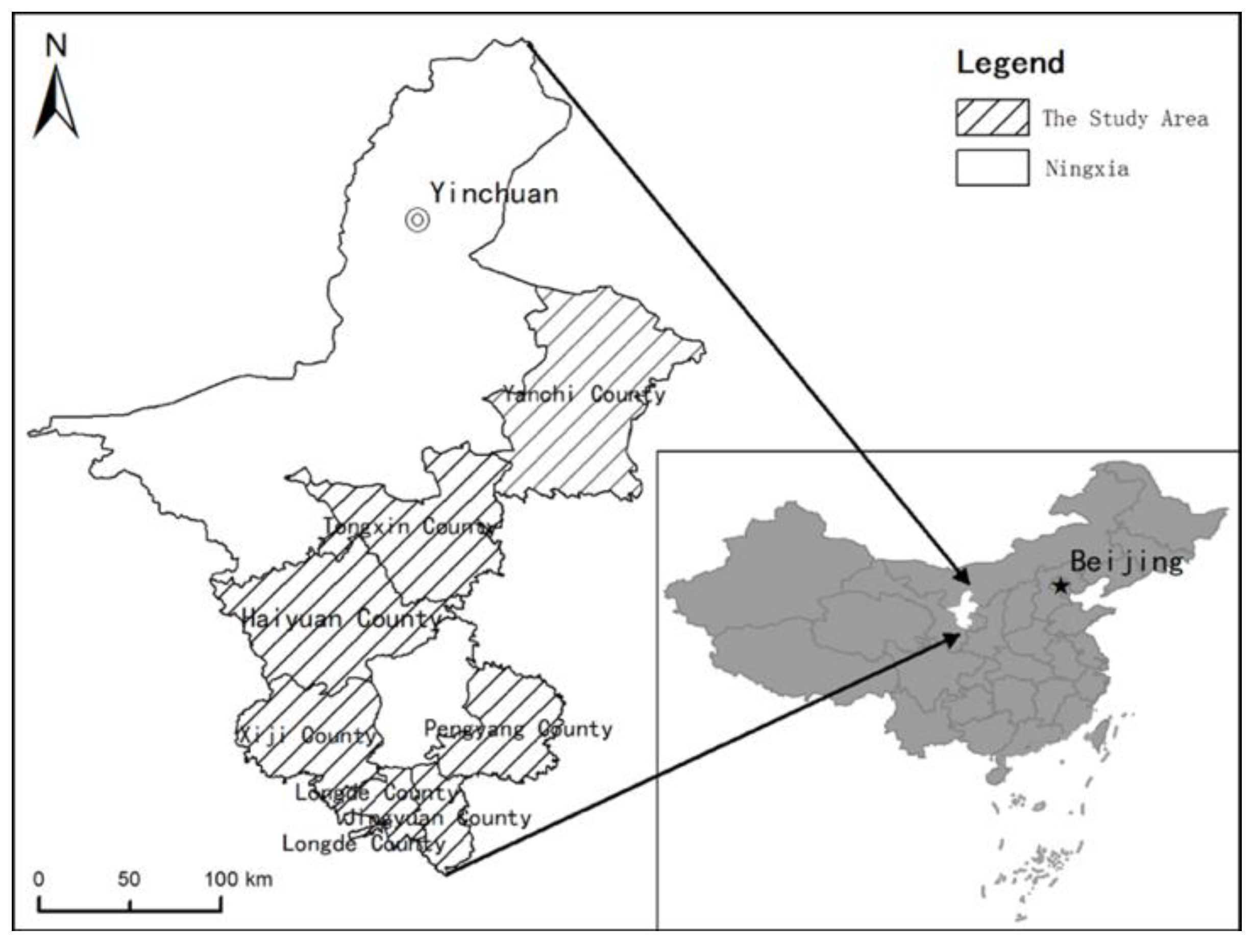
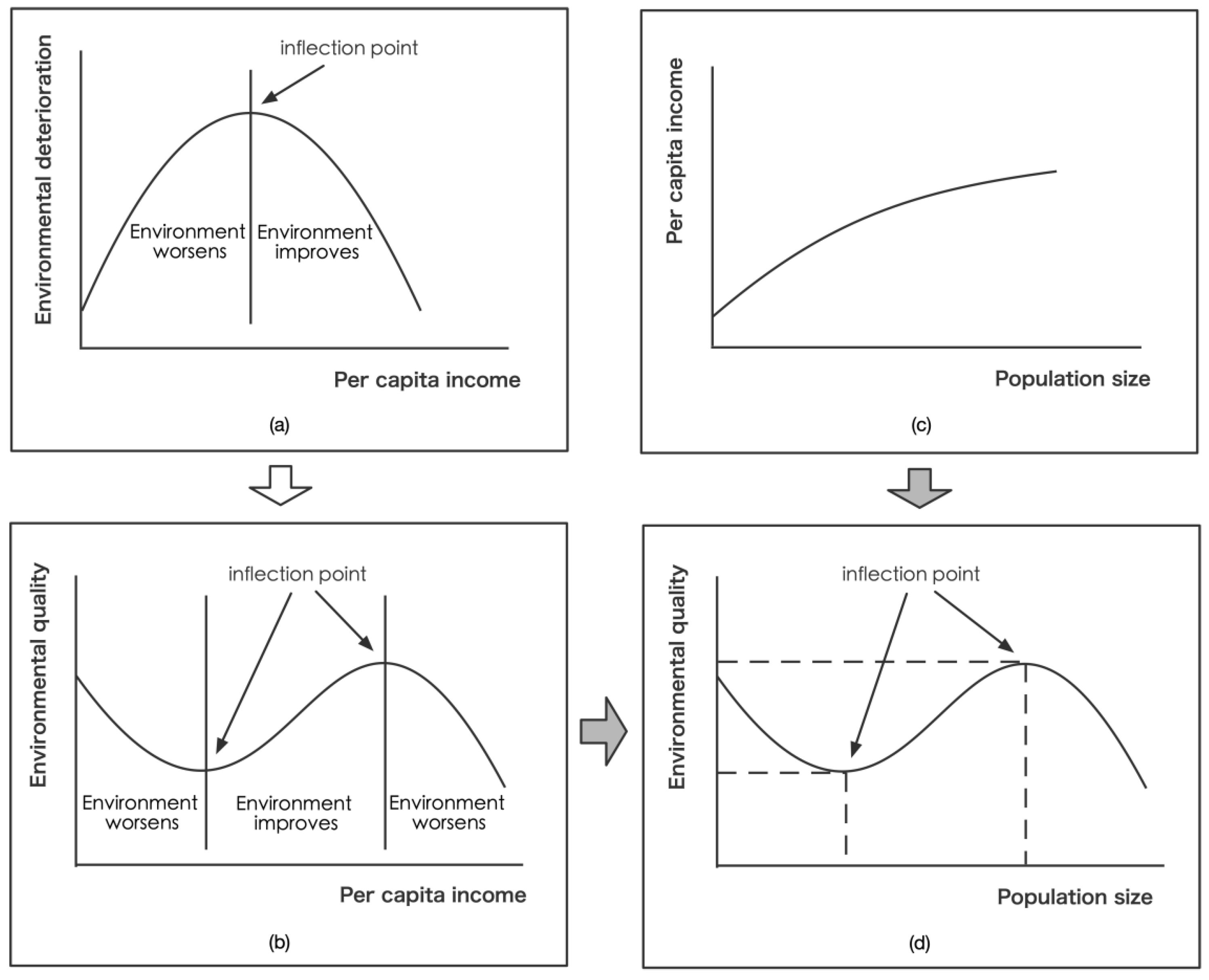
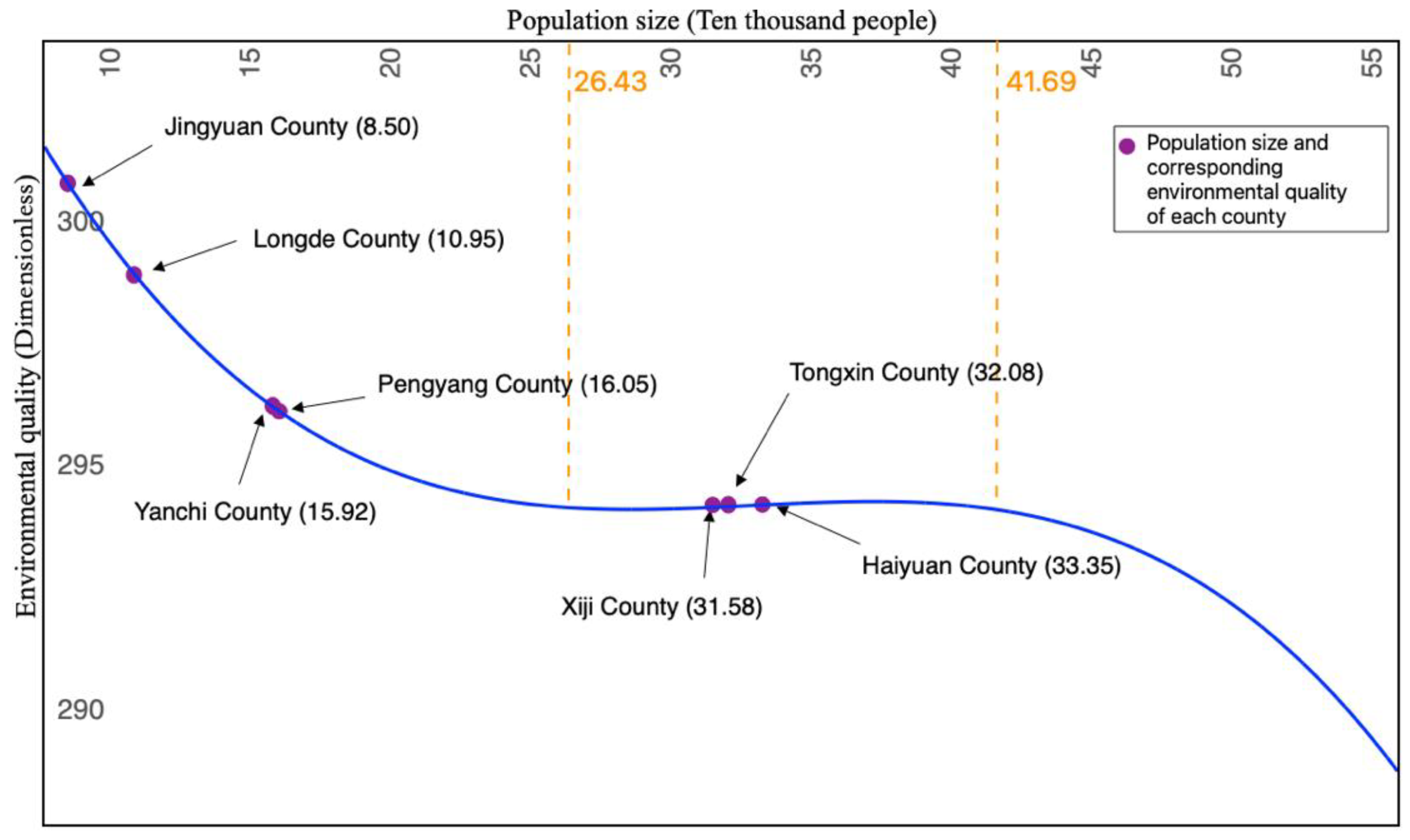
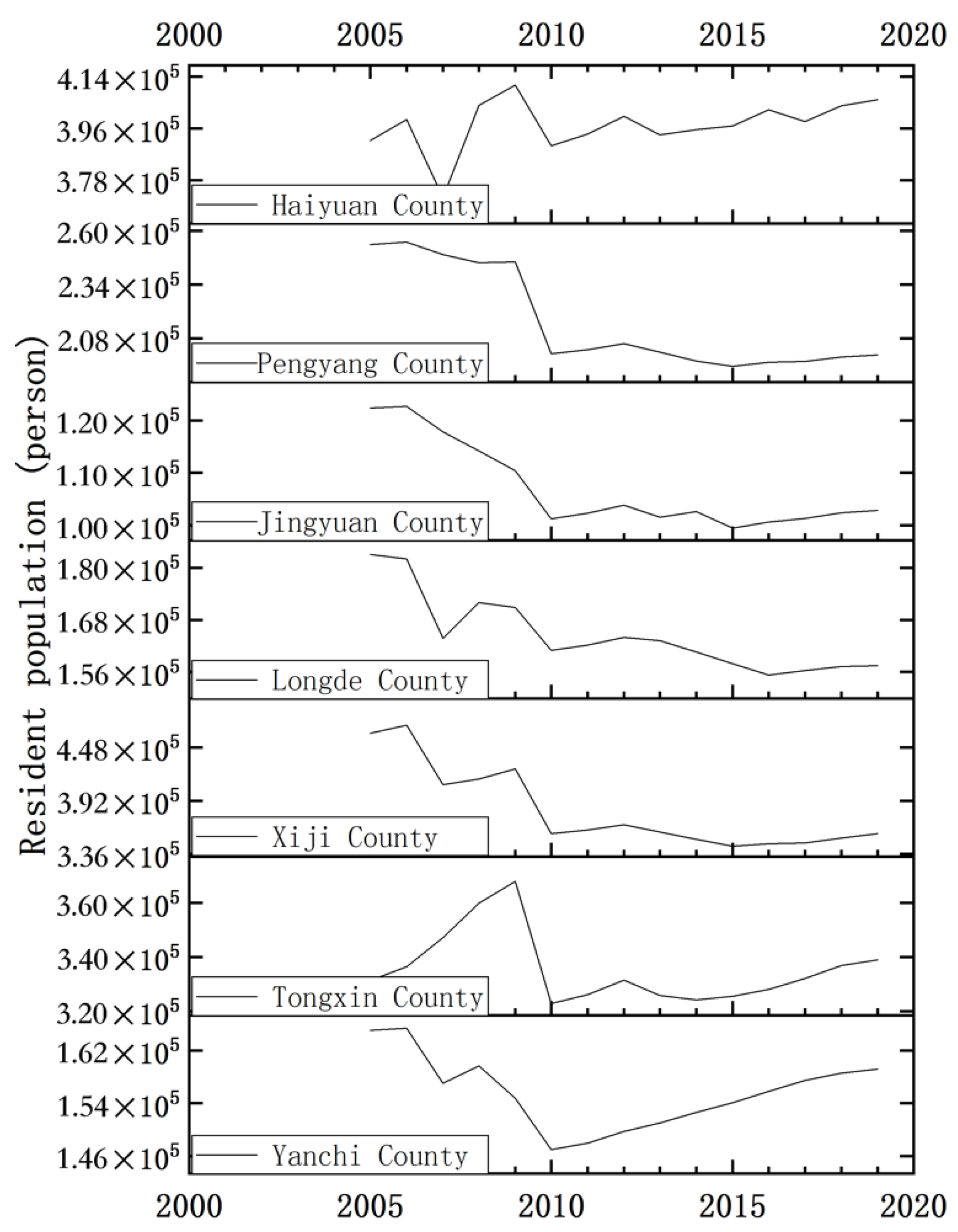
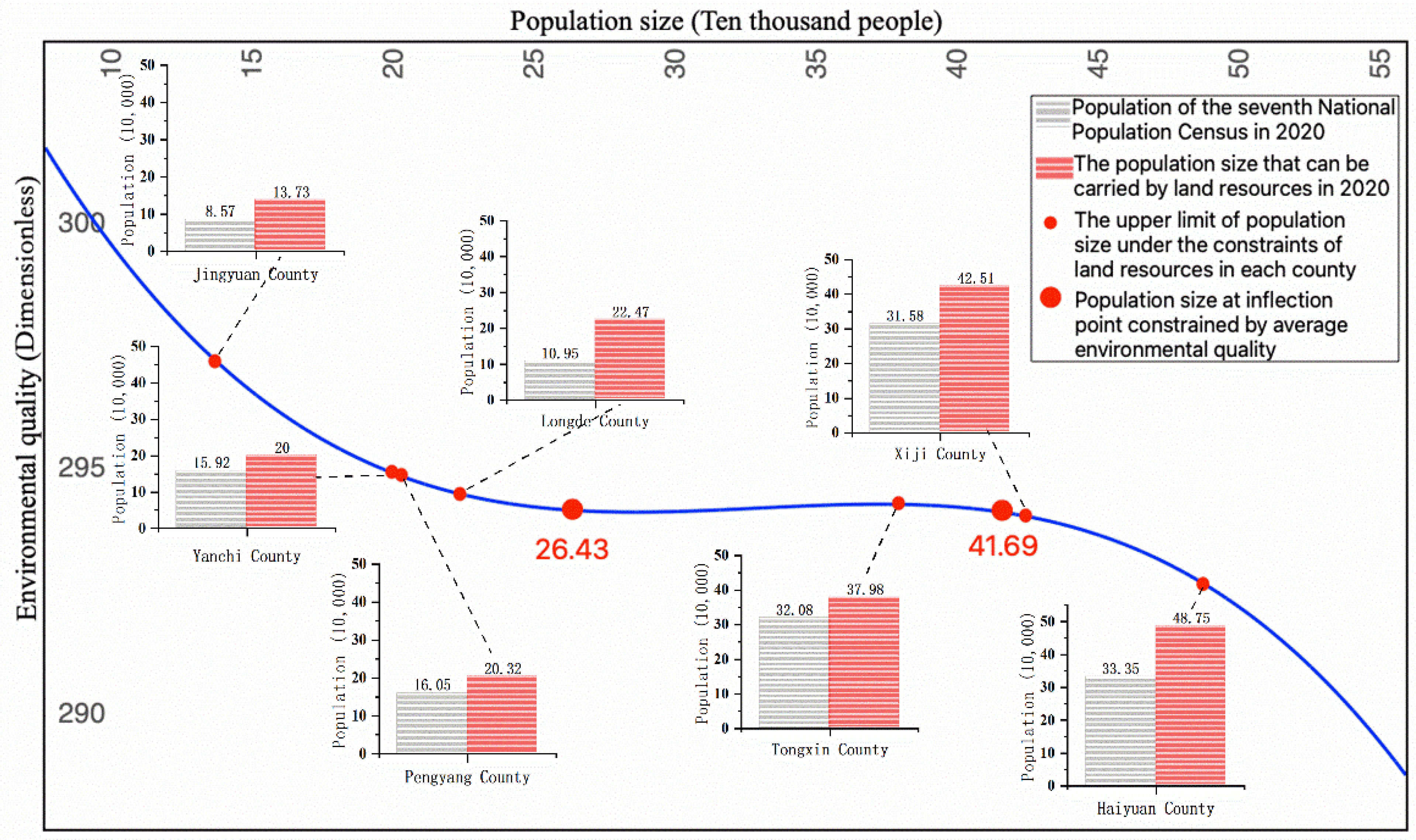
| Administrative Region | Industrial Land Use Intensity (ha/100 Million Yuan) | Per Capita Living Land Area (m2/Person) |
|---|---|---|
| Xiji county | 45.85 | 383.38 |
| Longde County | 24.83 | 264.14 |
| Jingyuan County | 64.64 | 313.53 |
| Pengyang County | 27.35 | 570.08 |
| Tongxin County | 21.33 | 430.99 |
| Yanchi County | 36.63 | 888.87 |
| Haiyuan County | 62.36 | 385.39 |
| Variable | Category | Indicators | Unit |
|---|---|---|---|
| Population size (n) | Total population | Ten thousand people | |
| Environmental quality (EQ) | Degree of environmental pollution | Volume of sulfur dioxide emissions per square kilometer (PL) | t/100 hm2 |
| Volume of industrial soot (dust) emissions per square kilometer (PY) | t/100 hm2 | ||
| Volume of industrial nitrogen oxides discharged per square kilometer (PD) | t/100 hm2 | ||
| Annual proportion of excellent days of air quality (KQ) | % | ||
| Ecosystem foundation | Afforestation area this year (ZL) | khm2 | |
| Forest and grass coverage rate (LC) | % | ||
| Energy consumption intensity of economic activities | Total energy consumption by GDP (NH) | tce/10,000 Yuan |
| Administrative Region | Principal Component | PL | PY | PD | KQ | ZL | LC | NH |
|---|---|---|---|---|---|---|---|---|
| Seven Counties | 1 | 0.624 | 0.697 | 0.890 | 0.166 | −0.501 | 0.755 | 0.650 |
| 2 | −0.545 | −0.300 | 0.265 | −0.200 | 0.566 | 0.331 | 0.585 | |
| 3 | −0.098 | −0.302 | 0.051 | 0.934 | 0.037 | 0.207 | −0.013 | |
| Xiji County | 1 | 0.709 | 0.656 | 0.87 | 0.375 | −0.069 | −0.721 | 0.939 |
| 2 | 0.444 | −0.427 | 0.198 | 0.577 | 0.851 | 0.452 | −0.042 | |
| 3 | 0.495 | 0.487 | −0.159 | −0.682 | 0.437 | 0.072 | −0.206 | |
| Longde County | 1 | 0.851 | 0.038 | 0.548 | 0.635 | 0.664 | 0.641 | −0.564 |
| 2 | 0.094 | 0.846 | 0.727 | −0.493 | −0.472 | 0.08 | −0.115 | |
| 3 | 0.461 | 0.421 | −0.16 | 0.508 | −0.112 | −0.597 | 0.328 | |
| Pengyang County | 1 | 0.497 | −0.403 | −0.029 | 0.872 | 0.836 | 0.879 | −0.563 |
| 2 | −0.301 | 0.641 | −0.716 | 0.357 | 0.469 | 0.043 | 0.629 | |
| 3 | 0.757 | 0.463 | 0.638 | 0.081 | 0.152 | −0.123 | 0.465 | |
| Jingyuan County | 1 | 0.915 | 0.521 | 0.617 | −0.869 | 0.273 | −0.787 | 0.635 |
| 2 | −0.344 | 0.591 | 0.698 | 0.45 | 0.086 | 0.578 | 0.628 | |
| 3 | −0.084 | −0.449 | −0.057 | 0.152 | 0.922 | −0.069 | 0.269 | |
| Haiyuan County | 1 | 0.93 | 0.699 | 0.591 | −0.585 | −0.624 | 0.636 | −0.06 |
| 2 | 0.283 | −0.585 | 0.23 | 0.754 | −0.212 | 0.424 | −0.808 | |
| 3 | 0.01 | 0.341 | 0.729 | 0.003 | 0.593 | −0.527 | −0.465 | |
| Tongxin County | 1 | 0.634 | 0.929 | 0.909 | −0.34 | −0.534 | 0.002 | −0.82 |
| 2 | −0.385 | 0.207 | 0.173 | −0.476 | 0.622 | 0.978 | −0.076 | |
| 3 | 0.575 | 0.077 | −0.252 | −0.608 | 0.109 | −0.077 | 0.434 | |
| Yanchi County | 1 | −0.215 | 0.771 | 0.934 | 0.39 | 0.123 | −0.549 | 0.805 |
| 2 | 0.886 | −0.197 | 0.257 | −0.184 | 0.772 | 0.52 | 0.454 | |
| 3 | 0.342 | 0.44 | 0.087 | 0.549 | −0.493 | 0.632 | −0.19 |
| Variable | Coef. | Std. Err. | z-Value |
|---|---|---|---|
| n | −1.5988 *** | 0.4953 | −3.23 |
| n2 | 0.0494 *** | 0.1700 | 2.91 |
| n3 | −0.0005 *** | 0.0002 | −2.65 |
| GDP | 0.0015 | 0.0060 | 0.24 |
| UR | 0.0379 *** | 0.0058 | 6.51 |
| Constant | 311.0892 *** | 68.4265 | 4.55 |
| chi2(1) | 7.02 *** | - | - |
| Administrative Region | Average Natural Growth Rate (‰) | Average Proportion of Ethnic Minority Population (%) | Ranking of the Proportion of Minority Population * |
|---|---|---|---|
| Xiji County | 12.46 | 57.63 | 6 |
| Longde County | 6.57 | 11.99 | 19 |
| Pengyang County | 9.92 | 30.42 | 10 |
| Jingyuan County | 10.63 | 78.99 | 2 |
| Haiyuan County | 12.94 | 71.65 | 3 |
| Tongxin County | 13.08 | 87.58 | 1 |
| Yanchi County | 8.79 | 2.32 | 22 |
| Ningxia | 8.73 | 35.83 |
Publisher’s Note: MDPI stays neutral with regard to jurisdictional claims in published maps and institutional affiliations. |
© 2022 by the authors. Licensee MDPI, Basel, Switzerland. This article is an open access article distributed under the terms and conditions of the Creative Commons Attribution (CC BY) license (https://creativecommons.org/licenses/by/4.0/).
Share and Cite
Chen, X.; Song, Y.; Fan, X.; Ma, J. Sustainable Population Size at the County Level under Limited Development Policy Constraints: Case Study of the Xihaigu Mountain Area, Northwest China. Int. J. Environ. Res. Public Health 2022, 19, 9560. https://doi.org/10.3390/ijerph19159560
Chen X, Song Y, Fan X, Ma J. Sustainable Population Size at the County Level under Limited Development Policy Constraints: Case Study of the Xihaigu Mountain Area, Northwest China. International Journal of Environmental Research and Public Health. 2022; 19(15):9560. https://doi.org/10.3390/ijerph19159560
Chicago/Turabian StyleChen, Xueli, Yongyong Song, Xingang Fan, and Jing Ma. 2022. "Sustainable Population Size at the County Level under Limited Development Policy Constraints: Case Study of the Xihaigu Mountain Area, Northwest China" International Journal of Environmental Research and Public Health 19, no. 15: 9560. https://doi.org/10.3390/ijerph19159560
APA StyleChen, X., Song, Y., Fan, X., & Ma, J. (2022). Sustainable Population Size at the County Level under Limited Development Policy Constraints: Case Study of the Xihaigu Mountain Area, Northwest China. International Journal of Environmental Research and Public Health, 19(15), 9560. https://doi.org/10.3390/ijerph19159560







